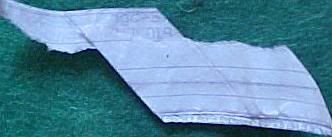I have finally figured out the 'formula' for designing a paper patch! I can now take any boolit that is to be patched, measure and design the patch using CAD and print out an A4 sheet full of patches, cut them out, wet them and roll them and they fit perfectly.
Not the patch for the PPCBoo below.
Note the curved top and bottom edges for a tapered or two-diameter boolit. The boolit weight is printed on the patch were it remains exposed.
The line is the correct seating depth.
Perfect 'eye' centralization every time.
With this design technique, aligning the boolit on the patch is a breeze and the patch just wraps on straight. The start and end aligns perfectly too although that is not a necessity - I just like it that way.
This works particularly well for tapered boolits. The same technique will work for parrallel boolits only there would be no curved top and bottom edges.

|
   
   
|


|





 Reply With Quote
Reply With Quote
 I plan to add a small chamfer on the bases to avoid that 'feathering' effect.
I plan to add a small chamfer on the bases to avoid that 'feathering' effect.












